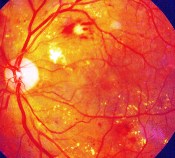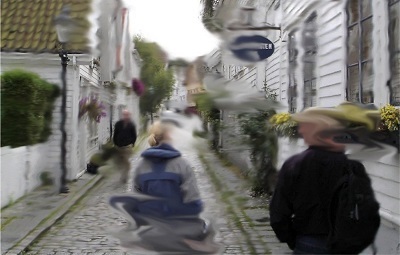
New diabetic retinopathy research from Australia and Singapore suggests that “the severity and progression of diabetic retinopathy can be a useful indicator to prompt the assessment of psychological well-being, particularly in individuals with other risk factors.”
The researchers further indicate that doctors who are treating adults with chronic disabling eye disease “should be alert and sensitive to potential indicators of depression such as sad mood, poor sleep and appetite, impaired concentration, and diminished self-esteem.”
In his Invited Commentary/Response to this newly-published mental health and eye care research, Peter V. Rabins, MD states the case for depression screening more forcefully: “Busy clinicians must balance their focus on the presenting disease of a patient with a duty to detect other co-morbidities [i.e., the presence of two or more chronic diseases or conditions at the same time] that the patient might be experiencing. Because depression affects 25% to 40% of individuals with significant eye pathology, it is reasonable to ask whether ophthalmologists should take specific steps to detect depression and then refer those who have symptoms for further assessment and treatment.”
The Diabetes and Mental Health Research
This new diabetes and mental health research, entitled Association between Diabetes-Related Eye Complications and Symptoms of Anxiety and Depression, has been published “online first” in the July 7, 2016 edition of JAMA Ophthalmology. JAMA Ophthalmology is an international peer-reviewed journal published monthly by the American Medical Association.
The authors are Gwyneth Rees, PhD; Jing Xie, PhD; Eva K. Fenwick, PhD; Bonnie A. Sturrock, DPsych; Robert Finger, PhD; Sophie L. Rogers, MEpi; Lyndell Lim, MBBS, FRANZCO; and Ecosse L. Lamoureux, PhD, who represent the following institutions: the University of Melbourne, Australia; the National University of Singapore; and the National University of Singapore Graduate Medical School.
More about the Diabetes and Depression Research
Edited and excerpted from Diabetic Retinopathy Linked to Depression: Psychological screening may be indicated in severe cases, via MedPage Today:
Severe diabetic retinopathy [also called diabetic eye disease] was linked to depression, and its presence should prompt clinicians to inquire about a patient’s mental health, according to a new study in JAMA Ophthalmology.
After controlling for socio-demographic factors and clinical characteristics, including visual acuity, severe diabetic retinopathy was independently associated with greater depressive symptoms, reported the research team.
“Our findings highlight that a simple self-report question about mental health history, which is feasible to implement in clinical practice, along with records of vision and diabetic retinopathy status can be used to identify individuals with diabetes who are at risk for poor mental health,” the investigators said.
“The findings presented here highlight that the severity of diabetic retinopathy heightens the risk of depressive symptoms independent from the presence or degree of vision impairment and duration of diabetes. This association likely reflects the long-term burden of managing and coping with diabetic retinopathy in its advanced stages,” [the researchers] said.
“The association between depressive symptoms, diabetes, and diabetic retinopathy is likely to be bidirectional, [meaning that] the impairment and burden of diabetes and its complications can precipitate depression and vice versa, and depression can impair diabetes control through various biological and behavioral pathways,” they added.
More about Diabetic Retinopathy or Diabetic Eye Disease
Although people with diabetes are more likely to develop cataracts at a younger age and are twice as likely to develop glaucoma as are non-diabetics, the primary vision problem caused by diabetes is diabetic retinopathy, the leading cause of new cases of blindness and low vision in adults aged 20-65:
- “Retinopathy” is a general term that describes damage to the retina.
- The retina is a thin, light-sensitive tissue that lines the inside surface of the eye. Nerve cells in the retina convert incoming light into electrical impulses. These electrical impulses are carried by the optic nerve to the brain, which interprets them as visual images.
- Diabetic retinopathy occurs when there is damage to the small blood vessels that nourish tissue and nerve cells in the retina.
- “Proliferative” is a general term that means to grow or increase at a rapid rate by producing new tissue or cells. When the term “proliferative” is used in relation to diabetic retinopathy, it describes the growth, or proliferation, of abnormal new blood vessels in the retina. “Non-proliferative” indicates that this process is not yet occurring.
Four Stages of Diabetic Retinopathy
According to the National Eye Institute, diabetic retinopathy has four stages:
- Mild non-proliferative retinopathy: At this early stage, small areas of balloon-like swelling occur in the retina’s tiny blood vessels.
- Moderate non-proliferative retinopathy: As the disease progresses, some blood vessels that nourish the retina become blocked.
- Severe non-proliferative retinopathy: Many more blood vessels become blocked, which disrupts the blood supply that nourishes the retina. The damaged retina then signals the body to produce new blood vessels.
- Proliferative retinopathy: At this advanced stage, signals sent by the retina trigger the development of new blood vessels that grow (or proliferate) in the retina and the vitreous. Because these new blood vessels are abnormal, they can rupture and bleed, causing hemorrhages in the retina or vitreous. Scar tissue can develop and can tug at the retina, causing further damage or even retinal detachment.
In addition, fluid can leak into the macula, the small sensitive area in the center of the retina that provides detailed vision. This fluid can cause macular edema (or swelling), which can occur at any stage of diabetic retinopathy, although it is more likely to occur as the disease progresses.
Symptoms of Diabetic Eye Disease
Symptoms of diabetic retinopathy can include:
- Blurry vision or double vision
- Flashing lights, which can indicate a retinal detachment
- A veil, cloud, or streaks of red in the field of vision, or dark or floating spots in one or both eyes, which can indicate bleeding
- Blind or blank spots in the field of vision

A simulation of the ocular and functional effects of diabetic retinopathy
Henry Ford Center for Vision Rehabilitation and Research
You can read more at Diabetic Eye Disease: Causes and Symptoms and Treatements for Diabetic Eye Disease on the VisionAware website.
A Response to the Research and Support for Depression Screening by Ophthalmologists
In the same July 7, 2016 edition of JAMA Ophthalmology, in an Invited Commentary/Response entitled Depressive Symptoms in Ophthalmology Patients, Peter V. Rabins, MD, MPH, from the University of Maryland, expanded on the importance of this research for adults and older adults with any eye disease:
![the JAMA Network logo]()
Busy clinicians must balance their focus on the presenting disease of a patient with a duty to detect other co-morbidities [i.e., the presence of two or more chronic diseases or conditions at the same time] that the patient might be experiencing.
Because depression affects 25% to 40% of individuals with significant eye pathology, it is reasonable to ask whether ophthalmologists should take specific steps to detect depression and then refer those who have symptoms for further assessment and treatment.
There are several potential approaches to screening for co-morbidities of any sort. One method is to screen all individuals, a second is to screen only those at high risk, and a third is to further assess only those individuals who report the symptom or whom the [doctor] suspects might have the disorder.
This study by Reese [and colleagues] in JAMA Ophthalmology offers useful information in formulating answers to these questions. They found that individuals with moderate to severe diabetic retinopathy were at high risk of having depressive symptoms, while individuals with diabetic macular edema were not, and that it was the severity of the diabetic retinopathy, rather than the severity of the visual impairment, that correlated with depressive symptoms.
However, [because there were limitations in the way the researchers collected and analyzed the study data], their results cannot be used to decide whether universal screening is a more efficient strategy.
[Nevertheless], is it worthwhile to detect depressive symptoms in patients with eye disease? The answer is clearly yes. [Two recent studies of patients with age-related macular degeneration] suggest that clinicians treating individuals with chronic disabling eye disease should be alert and sensitive to potential indicators of depression, such as sad mood, poor sleep and appetite, impaired concentration, and diminished self-esteem. Patients reporting any of these symptoms should be asked if they have been feeling more depressed, and if so, whether they would like a referral to a counselor, social worker, psychiatrist, or psychologist.
More about the Research from JAMA Ophthalmology
Here is a helpful overview of the research, excerpted from the article abstract:
Importance: This study is needed to clarify inconsistent findings regarding the association between diabetes-related eye complications and psychological well-being.
Objective: To examine the association between severity of diabetic retinopathy and diabetic macular edema with symptoms of depression and anxiety in adults with diabetes.
Design, Setting, and Participants: A cross-sectional study was conducted in a tertiary eye hospital in Melbourne, Australia. The study comprised 519 participants with diabetes. The median duration of diabetes was 13 years. The study was conducted from March 1, 2009 to December 24, 2010.
[Editor’s note: A cross-sectional study analyzes a group of subjects at one specific point in time. A prospective study, on the other hand, measures a group of individuals over time and follows up with the study subjects in the future.]
Results: Of the 519 participants in the study, 170 were female; the [average] age was 64.9 years. 80 individuals (15.4%) screened positive for depressive symptoms and 118 persons (22.7%) screened positive for symptoms of anxiety. Severe non-proliferative diabetic retinopathy or proliferative diabetic retinopathy (explained above) was … associated with greater depressive symptoms after controlling for socio-demographic factors and clinical characteristics, including visual acuity. Diabetic macular edema was not associated with depressive symptoms. No association between diabetic retinopathy and symptoms of anxiety was identified.
Conclusions: Severe non-proliferative diabetic retinopathy or proliferative diabetic retinopathy, but not diabetic macular edema, was … associated with depressive symptoms. The severity of diabetic retinopathy could be an indicator to prompt monitoring of depression in at-risk individuals with diabetes. Further work is required to replicate these findings and determine the clinical significance of the association.